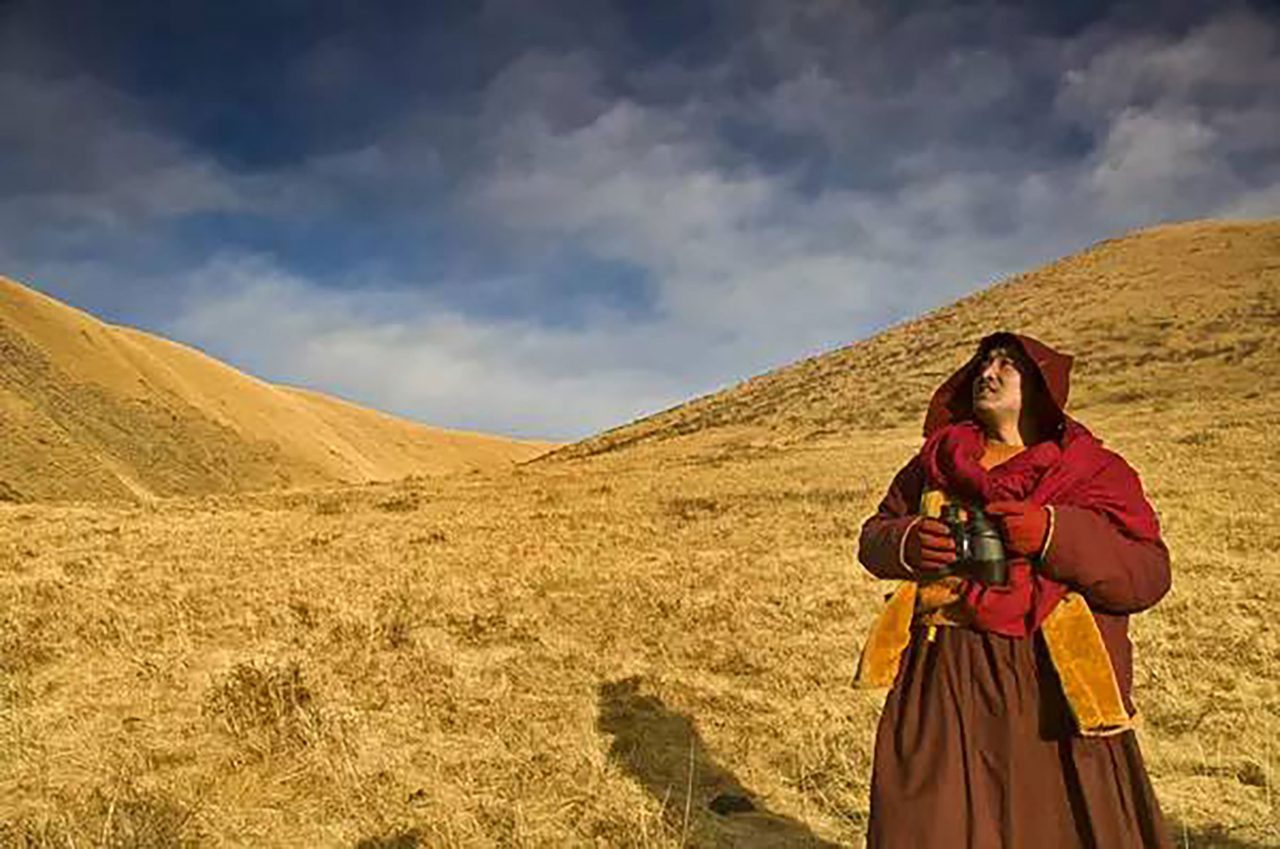A Conservationist in Monk’s Robes: Gen Tashi Sangpo, the Bird Lama
By Pat Leonard February 27, 2017
A stiff wind flutters a maroon robe as Gen Tashi Sangpo scans tawny grasslands flowing between mountains on a far corner of the Tibetan Plateau. He’s looking for a special bird—the endangered Tibetan Bunting. The bird nests in the tall grass and is only found in this one supremely remote part of the world. But Tashi Sangpo is much more than an avid bird watcher. He is a Buddhist monk, monastery abbot, naturalist, educator, artist, and filmmaker. To many, he is a hero. He is a highly respected leader of grassroots efforts to preserve nature. (The “Gen” title denotes that respect.) Many call him the “Bird Lama.”
Tashi Sangpo has spent the past two decades promoting conservation and biodiversity in the 5,000-square-mile Golok region of the Tibetan Plateau, where he grew up. Now part of Qinghai Province, China, the region encompasses the headwaters of the Yellow, Mekong, and Yangtze rivers. Birds stop there to rest during migrations north or south. Forests and grasslands are ringed by the Sermo mountain range, dotted with sparkling lakes and wetlands and crisscrossed by nomadic peoples herding yaks and sheep.

Tashi Sangpo came to the United States for the first time in November 2016 as a Global Innovation Fellow of Machik, a D.C.-based group focused on Tibet. He visited the Cornell Lab and spoke about conservation in his home region. His mission is based on a deceptively simple formula meant to create harmony between people and the environment:
Knowing. Loving. Protecting.
“If you don’t know the place, the environment, then you don’t have love for it, and if you don’t love, you won’t protect,” Tashi Sangpo said through translator Namgyal Tsepak, a Cornell Ph.D. student. “The approach I have taken is to educate people from different ages, young to old, so that they know, and from knowing they can grow to love the environment, and from there they can protect the environment.”
To work on the knowledge part of that equation, Tashi Sangpo reaches out to about 2,000 Tibetan children each year, educating and inspiring them about their environment and how to protect it. In 2004, he established the Nyangpo Yuzee Environment Protection Association. The association creates and distributes books, posters, and DVDs made by local people describing their land, the animals, the birds, and conservation actions being taken there. Ninety percent of its members are rural Tibetans.

Tashi Sangpo is training these local herders and farmers to be citizen scientists. These are people whose ancestors have lived in the region and worked on the land for thousands of years. Now their routine includes monitoring the environment. For example, they measure how far glaciers have receded (in the worst year, it was 660 feet [200 meters] from the previous measurement), how many bird species are there (130), whether there are fewer springs and lakes than the year before, and how many plants and animals are present. After collecting this vital baseline information in notebooks, the volunteers turn in their reports at Environment Protection Association headquarters. This group effort at data collection is how Tashi Sangpo learned the White Eared-Pheasant was disappearing from the region.
“Historically, there were supposed to be thousands of these birds in the area,” he said. “The number got really small, in the lower thirties. Since we started protecting them, the number has grown a little bit more in the past few years to more than 300 birds.” The species is restricted to China and has an estimated total population of at most 50,000. It’s listed as Near Threatened by the IUCN.
Tashi Sangpo also combines cultural knowledge with religious traditions to ensure the conservation message resonates with people. “The practice of Tibetan Buddhism is a very important part of why our efforts have been effective,” he says. “Compassion and love are at the core of the religion.” The fact that Tashi Sangpo and his fellow monks of the Pelyul Tharthang Monastery practice what they preach is another reason people can relate.
According to Machik’s Dr. Losang Rabgey, Tashi Sangpo has reached out to the more than 50 monasteries in the Golok region, asking the monks to talk to their communities about the importance of conservation.
“We call ourselves the people of snow land,” Tashi Sangpo told the Cornell Lab audience. “The saying goes that, if there are thousands of snow mountains, then the world is at peace; if the number of snow mountains decreases, it’s still peaceful, but there is danger lurking; and if there is no snow in the mountains, then the world is coming to an end. The number of snow mountains is a reflection of the health of the Earth…this is a traditional saying.”
Extra: Saving Vultures

All About Birds
is a free resource
Available for everyone,
funded by donors like you
American Kestrel by Blair Dudeck / Macaulay Library




